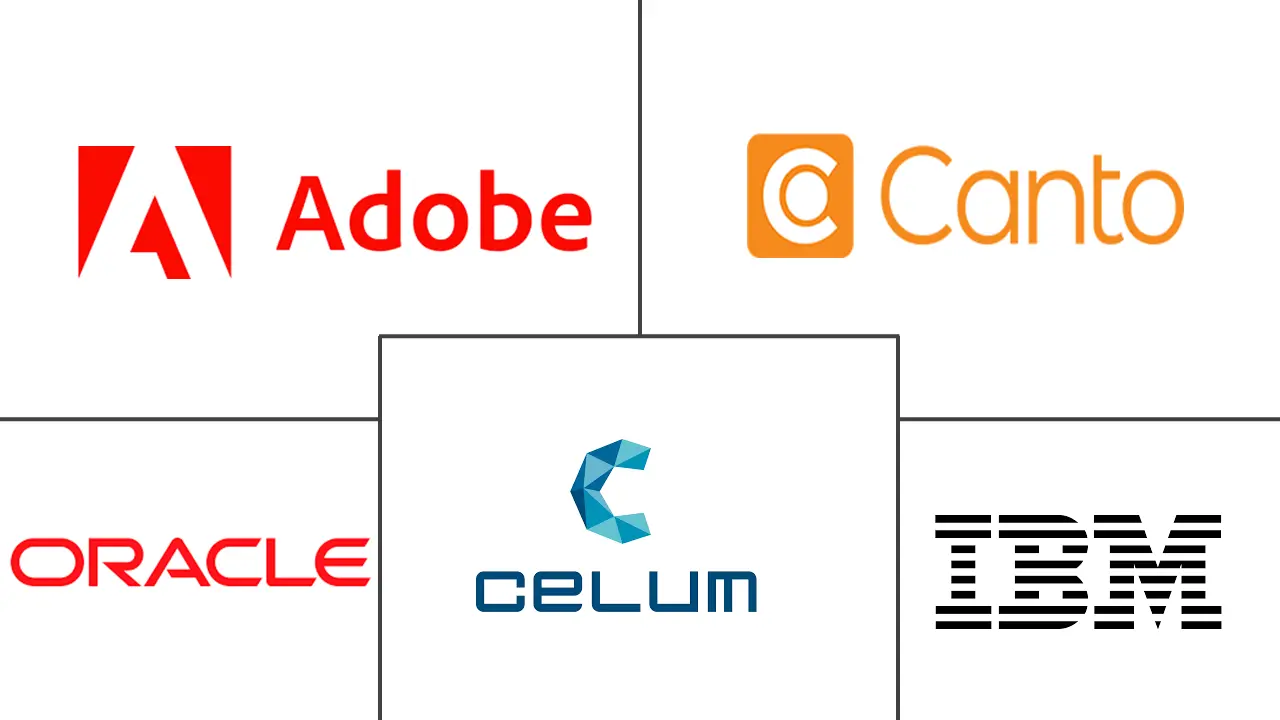Digital Asset Management Market Size and Share
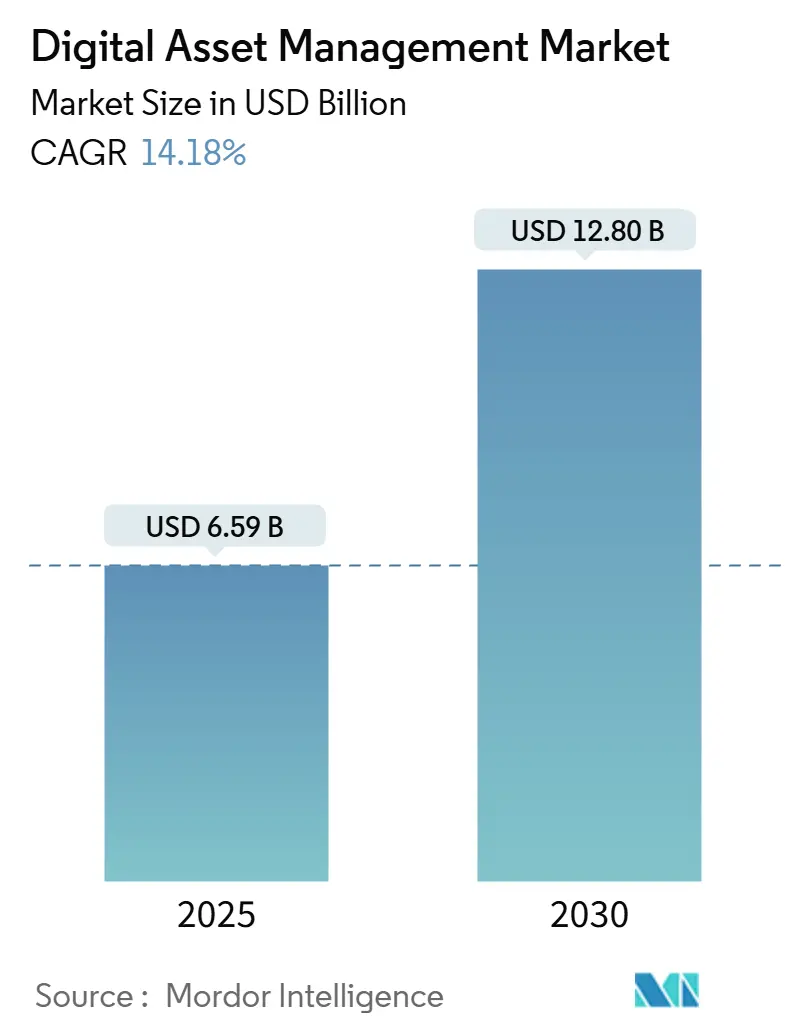
Digital Asset Management Market Analysis by Mordor Intelligence
The Digital Asset Management market is valued at USD 6.59 billion in 2025 and is forecast to reach USD 12.80 billion by 2030, advancing at a 14.18% CAGR. Demand is accelerating as enterprises reposition DAM from a cost center to a core pillar of omnichannel content strategy. Solution providers now embed AI for auto-tagging, rights management, and dynamic delivery, helping brands reduce asset search time by up to 40%. Generative AI pilots are already underway at 66% of large organizations, boosting personalization at scale.[1]Adobe, “Digital Trends Report,” adobe.com Regulatory change is another growth catalyst. Europe’s Accessibility Act, effective June 2025, requires richer metadata and alt-text, pushing companies to upgrade legacy systems. North America leads the adoption of cloud-native architectures, while the Asia-Pacific region is experiencing the fastest expansion, driven by the surge in mobile video streaming. At the same time, the high total cost of ownership and tightening data-sovereignty rules restrain smaller firms and heavily regulated sectors.
Key Report Takeaways
- By component, solutions held 72.3% of the Digital Asset Management market share in 2024, while Services are set to grow at a 17.9% CAGR through 2030.
- By deployment, the cloud segment accounted for 64% of the Digital Asset Management market size in 2024 and is forecast to expand at a 15.8% CAGR to 2030.
- By organization size, large enterprises accounted for 68.5% of 2024 revenue; SMEs, on the other hand, were projected to have the highest CAGR at 16.4% for the period 2025-2030.
- By application, sales and marketing enablement led with 34.7% revenue share in 2024, whereas Broadcast and Publishing is advancing at an 18.6% CAGR through 2030.
- By end-user industry, the media and entertainment sector contributed 27.9% of the Digital Asset Management market size in 2024; the retail and CPG sector is the fastest-growing vertical, with a 17.1% CAGR.
- By geography, North America led with 38.2% revenue share in 2024, whereas Asia-Pacific is is advancing at an 17.4% CAGR through 2030.
Global Digital Asset Management Market Trends and Insights
Drivers Impact Analysis
| Driver | (~) % Impact on CAGR Forecast | Geographic Relevance | Impact Timeline |
|---|---|---|---|
| Growing volume and velocity of rich media assets | +3.20% | Global, strongest in North America and Europe | Medium term (2-4 years) |
| Rapid shift to cloud-native AI-enhanced DAM platforms | +2.80% | North America with spill-over to Europe and APAC | Short term (≤2 years) |
| Surging demand for personalised video-streaming assets | +2.10% | APAC core with expanding global influence | Medium term (2-4 years) |
| Integration of DAM with headless CMS for real-time syndication | +1.90% | Global, led by North America and Europe | Short term (≤2 years) |
| Regulatory push for accessibility elevating metadata standards | +1.60% | Europe primary with worldwide uptake | Medium term (2-4 years) |
| Emergence of generative-AI-powered auto-tagging | +1.40% | Global, early in North America | Short term (≤2 years) |
| Source: Mordor Intelligence | |||
Growing Volume and Velocity of Rich Media Assets in Omnichannel Commerce
Marketing teams now devote 39% of budgets to content creation, much of it short-form video and interactive formats that require sophisticated metadata, rights tracking, and rendition management. Organizations that integrate Product Information Management with DAM repurpose assets across storefronts, social commerce, and marketplaces, maximizing ROI while protecting brand integrity. Coca-Cola links SKU-level data with creative files to drive real-time personalization across e-commerce sites. Companies without a robust DAM struggle with duplicate production and inconsistent messaging, eroding campaign effectiveness.
Rapid Shift to Cloud-Native AI-Enhanced DAM Platforms in North America
Enterprises such as T-Mobile decreased creative cycle times after moving from on-premise repositories to Adobe Experience Manager Assets, which uses AI for bulk tagging and rendition generation. SaaS delivery eliminates costly upgrades and supports distributed teams that need instant access. Early adopters report measurable OPEX savings and faster campaign launches, prompting competitors to accelerate migrations.
Surging Demand for Personalised Video Streaming Assets in Asia
Mobile-first consumers in China, Japan, and South Korea expect localized subtitles, thumbnails, and ad slates. Content owners deploy DAM to automate transcoding, manage rights windows, and feed recommendation engines. Investments in 5G and edge delivery further amplify demand for scalable asset orchestration that can push tailored streams in milliseconds.
Integration of DAM with Headless CMS for Real-Time Content Syndication
The Los Angeles Times consolidated 19 repositories into an API-first hub that now powers 130,000 stories across websites, apps, and smart speakers. Headless architecture decouples front-end presentation, allowing DAM to serve as the central content source while APIs handle instant distribution. Teams accelerate publishing, reduce manual uploads, and enforce brand guidelines seamlessly.
Restraints Impact Analysis
| Restraint | (~) % Impact on CAGR Forecast | Geographic Relevance | Impact Timeline |
|---|---|---|---|
| High total cost of ownership for enterprise-grade DAM suites | -1.60% | Global, higher in emerging markets | Medium term (2-4 years) |
| Data-sovereignty and residency mandates limiting cross-border storage | -1.20% | Europe, APAC, Middle East | Long term (≥4 years) |
| Fragmented legacy repositories hindering seamless migration | -0.90% | Global, higher in mature markets | Medium term (2-4 years) |
| Limited skilled workforce for AI-based metadata governance | -0.70% | Global, acute in emerging markets | Short term (≤2 years) |
| Source: Mordor Intelligence | |||
High Total Cost of Ownership for Enterprise-Grade DAM Suites in SMEs
Licensing fees, integration work, and the need for DAM specialists deter many smaller firms from enterprise platforms. Departments often adopt lightweight tools, creating silos that inflate support overhead and complicate consolidation efforts. Service providers now bundle change-management workshops and migration accelerators to close this adoption gap.
Data-Sovereignty and Residency Mandates Limiting Cross-Border Asset Storage
The UAE’s Federal Decree-Law 45 of 2021 requires sensitive data to be stored on servers inside the country, forcing multinationals to run regional instances or hybrid models. Similar localization rules appear across Europe and APAC, increasing infrastructure spend and complicating global workflows.
Segment Analysis
By Component: Services Propel Complex Transformations
The Solutions segment captured a 72.3% share, establishing a baseline for enterprise adoption. Platforms now bundle AI transcription, color correction, and rights clearance, making the Digital Asset Management market an integral part of broader digital-experience stacks. Large brands utilize orchestration rules to automatically assemble campaign kits, ensuring the creation of regulatory-ready content sets.
Meanwhile, Services revenue is forecast to outpace software at a 17.9% CAGR as firms rely on partners for taxonomy design, migration from fragmented archives, and user-training programs. Managed-service engagements that wrap governance dashboards and KPI tracking are becoming standard. Implementations supported by specialists demonstrate a 196% ROI through faster retrieval and compliance savings.
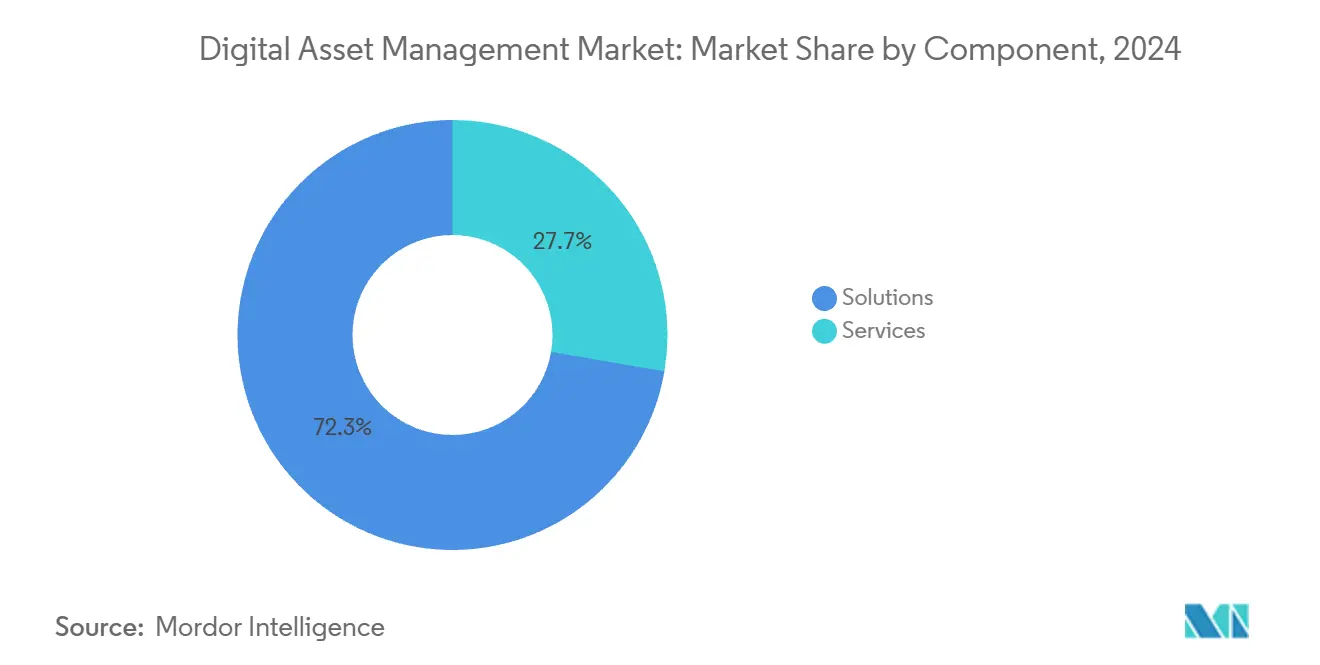
By Deployment Mode: Cloud Unlocks Continuous Innovation
Cloud installations account for 64% of 2024 revenue, as updates flow seamlessly and the total cost per asset decreases as storage tiers are automatically scaled. Clients integrate AI Video Intelligence entirely through SaaS APIs, expanding their digital presence across new channels without downtime.
On-premise installations persist in defense, government, and healthcare, but hybrid patterns are gaining traction, where sensitive master files remain behind the firewall while derivatives are streamed from regional clouds. Continuous delivery of features such as semantic search keeps the cloud model ahead, fueling a 15.8% CAGR and reinforcing the primacy of the Digital Asset Management market in modern tech stacks.
By Organisation Size: Enterprise Scale Meets SME Agility
Large enterprises contributed 68.5% of 2024 revenue by integrating DAM with ERP, CRM, and martech suites to maintain global brand integrity. Complex permissions map to business units, and AI classifiers handle multilingual tagging. At the same time, cloud subscriptions and low-code connectors open the Digital Asset Management market to SMEs that previously relied on shared drives. Vendors target this cohort with usage-based pricing and pre-built creative tool plug-ins.
SMEs are projected to grow at a 16.4% CAGR. NYALA Digital Asset AG utilizes tokenized securities to democratize SME access to capital for technology upgrades, thereby addressing the EUR 800 billion (USD 925.56 billion) funding gap in Europe.
By Application: Marketing Enablement Leads Multichannel Transformation
Sales and Marketing Enablement applications held a 34.7% share as teams deploy DAM to serve consistent imagery and copy to ads, landing pages, and retail partners. Real-time rendition services personalize hero banners for each market segment, while approval workflows shorten go-live cycles.
The Broadcast and Publishing segment expands at an 18.6% CAGR because newsrooms and streaming services ingest terabytes of data daily and require automated rights checks. POLITICO migrated 190,000 articles into a single hub to support 56 million monthly visitors. The Digital Asset Management market size for this workflow is projected to widen as subscription models demand constant content refresh.
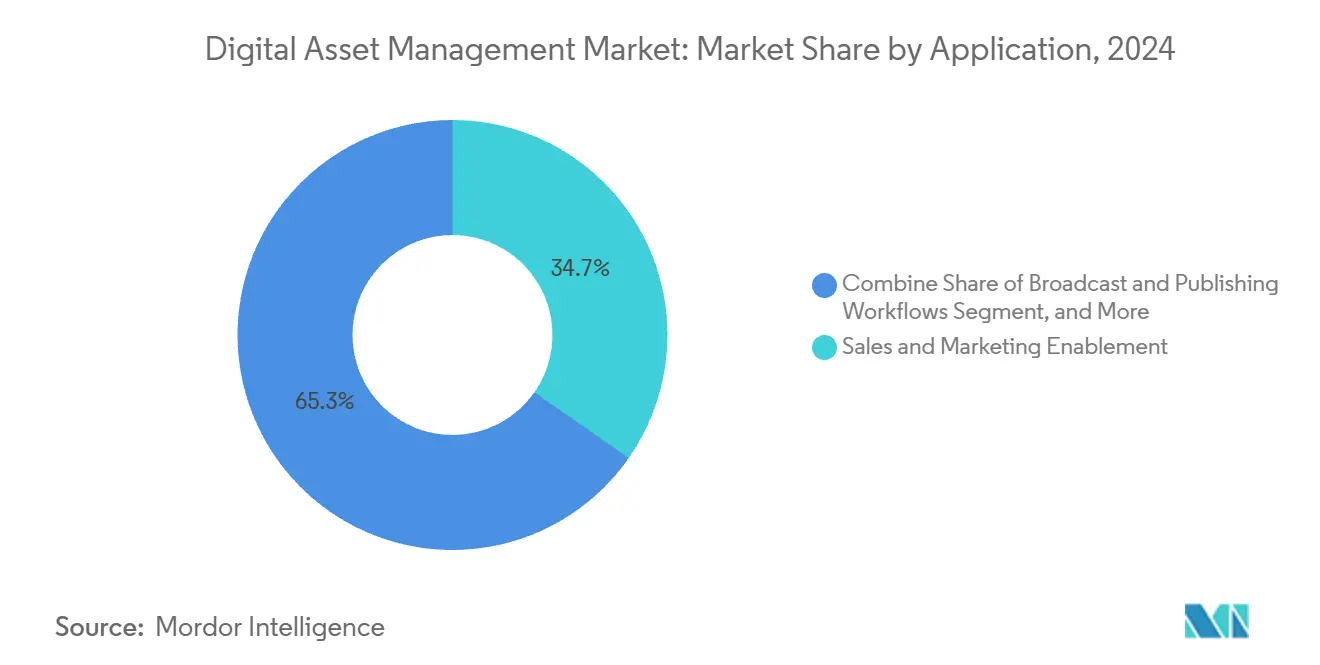
Note: Segment shares of all individual segments available upon report purchase
By End-User Industry: Media and Entertainment Sets the Pace
Media and Entertainment accounts for 27.9% of spending because studios, broadcasters, and game publishers depend on intricate asset lifecycles. The American Film Institute made millions of archival assets accessible to staff via AI-enabled discovery, showcasing significant productivity gains.
Retail and CPG are the fastest-growing sectors at a 17.1% CAGR. A global consumer-goods firm saved USD 3 million annually after connecting its DAM with a digital shelf that cut listing times by 68%. As marketplaces impose stricter content standards, the Digital Asset Management market empowers brands to synchronize imagery, packaging updates, and localized labels instantly.
Geography Analysis
North America led with a 38.2% share in 2024, as enterprises adopted AI-rich cloud suites and hyperscale providers enhanced their compliance certifications. DeFi Technologies projected USD 201.07 million in revenue from Solana-based products, illustrating deep regional expertise in tokenized asset management, and the region's mature ad-tech ecosystem drives higher per-user content spend, solidifying its leadership in the Digital Asset Management market. The region’s mature ad-tech ecosystem drives higher per-user content spend, solidifying its leadership in the Digital Asset Management market.
Asia-Pacific is forecast to post a 17.4% CAGR through 2030. The DAM Sydney 2025 conference highlighted the growing demand for multilingual asset orchestration across FMCG, healthcare, and government programs. Rising smartphone penetration and social commerce are expanding the use cases for instant video personalization at scale. Government smart-city initiatives also encourage the development of unified content hubs to power public-service apps.
Europe’s growth is anchored in accessibility mandates and strict privacy frameworks. The Digital Asset Management market size for compliance-ready solutions is expanding as firms retrofit their heritage collections with alt-text and granular consent tracking. Vendors differentiate on advanced metadata, versioning, and anonymization features to satisfy GDPR and regional localization laws. Osborne Clarke advises that early conformance with the European Accessibility Act enhances brand reputation and mitigates legal risk
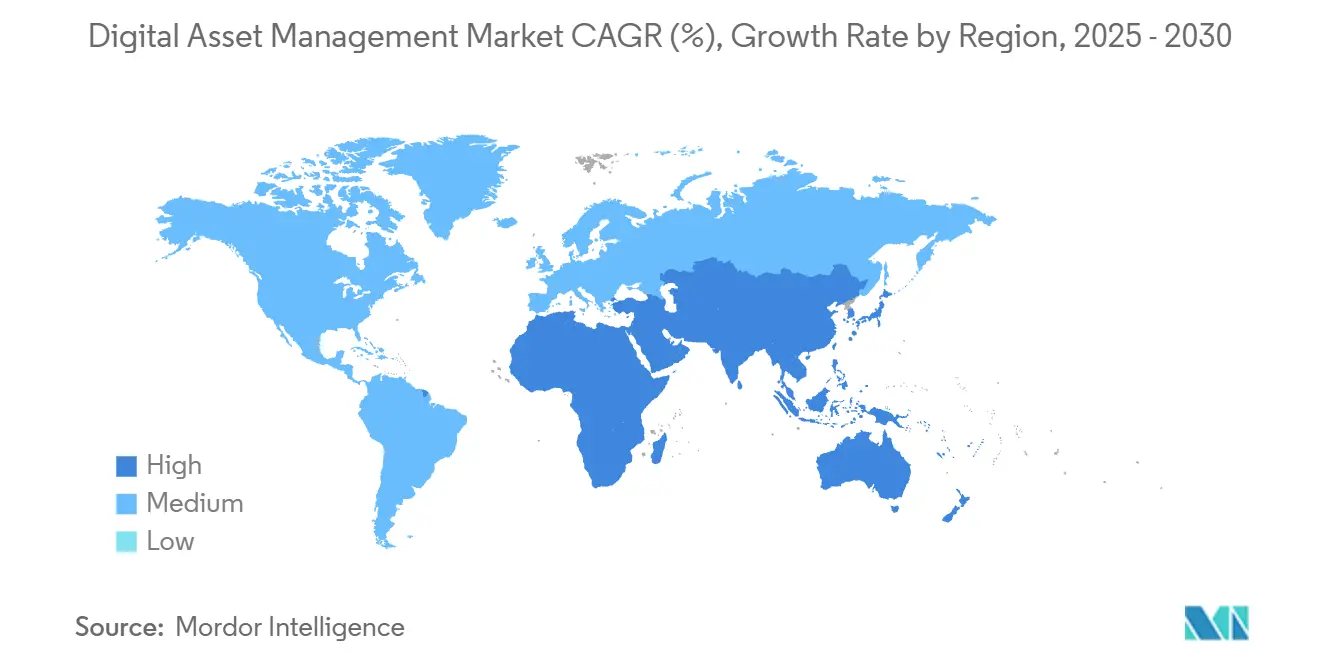
Competitive Landscape
The Digital Asset Management market is moderately concentrated. Adobe, Aprimo, MediaValet, Acquia, and Orange Logic collectively command a significant presence, but agile newcomers push innovation cycles forward at a faster pace. Competitive strategy revolves around three pillars. AI depth, vertical templates, and open API ecosystems. Aprimo’s Planning and Critic Agents automate content calendars and quality checks, freeing regulated industries from the burden of manual audits. Acquia extended its platform with AI Video Creator, bringing low-code editing and automated color filtering to marketers.[2] Acquia, “October 2024 Product Release Notes,” acquia.com MediaValet partners with NVIDIA to accelerate visual search on GPUs, while Orange Logic promotes no-code connectors for laboratory-grade imaging.
White-space opportunities include 3D and AR asset orchestration as ecommerce and product visualization mature. Blockchain-verified provenance attracts media firms in the fight against deepfakes.
Start-ups leverage micro-services and consumption pricing to win mid-market deals, challenging incumbents that still rely on monolithic architectures. Consolidation continued when Hilbert Group acquired Liberty Road Capital, adding digital-asset expertise to its portfolio.[3]Hilbert Group, “Acquisition of Liberty Road Capital,” hilbert.group The dynamic signals an arms race for AI talent and proprietary training data inside the Digital Asset Management market.
Digital Asset Management Industry Leaders
-
Adobe Inc.
-
Canto Inc.
-
CELUM GmbH
-
Oracle Corporation
-
IBM Corp.
- *Disclaimer: Major Players sorted in no particular order

Recent Industry Developments
- May 2025: Aprimo unveiled AI Agents that automate planning, metadata management, and compliance for regulated sectors
- May 2025: DeFi Technologies reaffirmed USD 201.07 million 2025 revenue guidance as the largest institutional manager of Solana in North America
- May 2025: NYALA Digital Asset AG launched a securities platform under Germany’s Electronic Securities Act to expand SME funding
- April 2025: PFM CRYPTO introduced a zero-fee digital asset management platform with AI income optimization and 9.2 million users
Global Digital Asset Management Market Report Scope
The study tracks the key market parameters, underlying growth influencers, and major vendors operating in the industry, which supports the market estimations and growth rates over the forecast period. The study also tracks the revenue accrued from the solutions used by various end users across the globe. In addition, the study provides the digital asset management market trends, along with key vendor profiles. The study further analyses the overall impact of COVID-19 on the ecosystem.
The digital asset management market is segmented by deployment (on-premise, cloud (SaaS)), organization size (SMEs (small and medium enterprises), large enterprises), end user (media and entertainment, BFSI, government, healthcare, retail, manufacturing, and other end users), and geography (North America [United States and Canada], Europe [United Kingdom, Germany, France, and Rest of Europe], Asia-Pacific [China, Japan, India, and Rest of Asia-Pacific], Rest of the World [Latin America and Middle East and Africa]). The report offers market forecasts and size in value (USD) for all the above segments.
| Solutions |
| Services |
| On-Premise |
| Cloud (SaaS) |
| SMEs |
| Large Enterprises |
| Sales and Marketing Enablement |
| Broadcast and Publishing Workflows |
| Product and E-commerce Management |
| Photography, Graphics and Design Repositories |
| Document and Knowledge Management |
| Media and Entertainment |
| BFSI |
| Government and Public Sector |
| Healthcareand Life Sciences |
| Retail and CPG |
| Manufacturing |
| IT and Telecom |
| Others (Education, Non-Profit) |
| North America | United States | |
| Canada | ||
| Mexico | ||
| South America | Brazil | |
| Argentina | ||
| Rest of South America | ||
| Europe | United Kingdom | |
| Germany | ||
| France | ||
| Spain | ||
| Italy | ||
| Rest of Europe | ||
| Asia-Pacific | China | |
| India | ||
| Japan | ||
| Australia | ||
| South Korea | ||
| Rest of Asia-Pacific | ||
| Middle East and Africa | Middle East | Saudi Arabia |
| United Arab Emirates | ||
| Turkey | ||
| Rest of Middle East | ||
| Africa | South Africa | |
| Kenya | ||
| Rest of Africa | ||
| By Component | Solutions | ||
| Services | |||
| By Deployment Mode | On-Premise | ||
| Cloud (SaaS) | |||
| By Organisation Size | SMEs | ||
| Large Enterprises | |||
| By Application | Sales and Marketing Enablement | ||
| Broadcast and Publishing Workflows | |||
| Product and E-commerce Management | |||
| Photography, Graphics and Design Repositories | |||
| Document and Knowledge Management | |||
| By End-User Industry | Media and Entertainment | ||
| BFSI | |||
| Government and Public Sector | |||
| Healthcareand Life Sciences | |||
| Retail and CPG | |||
| Manufacturing | |||
| IT and Telecom | |||
| Others (Education, Non-Profit) | |||
| By Geography | North America | United States | |
| Canada | |||
| Mexico | |||
| South America | Brazil | ||
| Argentina | |||
| Rest of South America | |||
| Europe | United Kingdom | ||
| Germany | |||
| France | |||
| Spain | |||
| Italy | |||
| Rest of Europe | |||
| Asia-Pacific | China | ||
| India | |||
| Japan | |||
| Australia | |||
| South Korea | |||
| Rest of Asia-Pacific | |||
| Middle East and Africa | Middle East | Saudi Arabia | |
| United Arab Emirates | |||
| Turkey | |||
| Rest of Middle East | |||
| Africa | South Africa | ||
| Kenya | |||
| Rest of Africa | |||
Key Questions Answered in the Report
What is the forecasted size of the Digital Asset Management market by 2030?
The market is projected to reach USD 12.80 billion by 2030, reflecting a 14.18% CAGR from 2025 values.
Which segment is growing the fastest within the Digital Asset Management market?
Services are expanding the quickest at a 17.9% CAGR as enterprises seek expertise for migrations, taxonomies, and change management.
Why are cloud deployments preferred for Digital Asset Management platforms?
Cloud models deliver continuous innovation, lower upfront costs, and global accessibility, capturing 64% of 2024 revenue and growing at 15.8% CAGR.
How does the European Accessibility Act influence DAM investments?
The Act mandates accessible digital assets starting June 2025, prompting European organizations to upgrade metadata capabilities and automated captioning.
Which end-user verticals are poised for the highest growth?
Retail and CPG companies are projected to post a 17.1% CAGR as they link DAM with product data to power omnichannel personalization.
What role does AI play in modern DAM solutions?
AI automates tagging, transcription, and quality checks, reducing asset retrieval times by up to 40% and enabling hyper-personalized experiences at scale.
Page last updated on:
